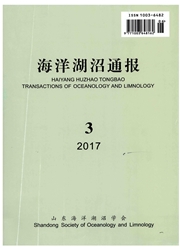

 中文摘要:
中文摘要:
根据"东方红2"于2011年9月在南海西南部11°N~15°N、111°E~114°E海域测得的CTD资料及据此的地转流计算结果,结合南海的海流数值计算结果的对比分析,得出南海西南部海盆附近水域中尺度涡的基本分布规律及其水文特征:(1)以12°N~13°N附近宽约100km的条带作为分界,其北部是气旋式运动,南部是反气旋式运动。(2)气旋涡中心产生上升流,底层水上升,中心密度大。表层表现为低温高盐高密特征;200m层表现为低温低盐高密特征;1 000m层则表现为低温高盐高密特征。(3)在反气旋涡中心产生下降流,海水密度小。表层表现为高温低盐低密特征;200m层表现为高温高盐低密特征;1 000m层则表现为高温低盐低密特征。(4)在8~9月,上述北气旋、南反气旋的分布流态基本不变;(5)季风的影响是因素之一,而地形影响更是调查区域双涡旋流动结构的重要动力机制。
 英文摘要:
英文摘要:
A field survey aboard R/V Dongfanghong 2 was conducted in the southwestern (11°N~15° N, 111°E~114°E ) South China Sea ( SCS ) in September 2011. Based°n the in situ data from CTD, geostrophic currents could be computed. Combined with the numerical model results, analyses of the mesoscale eddies in the southwestern basin in SCS are shown and the conclusions can be summarized as follows. (1) There is a dipole structure associated with the offshore jet between 12°N~13°N, with an anticyclonic eddy south of the jet and a cyclonic eddy north of it. (2) The cyclonic eddy causes upwelling, and the alongshore wind can easily pump the cold and dense water from the bottom to the surface. The survey area is low in temperature and high in salinity at the surface, low in both temperature and salinity at 200 m, and opposite to the surface at 1 000 m. (3) In contrast to the cyclonic eddy, and the anticyclonic eddy causes downwelling. As a result, the density of column is lower than around, the temperature and salinity at the surface is high and low, respectively, and they are both high at 200 m, while at 1 000m temperature is high and salinity is low. (4) The aforementioned flow pattern changes very little during August to September. (5) Although the southwest moonson is one of the factors, the main mechanism for the observed flow pattern is topographic effects.
 同期刊论文项目
同期刊论文项目
 同项目期刊论文
同项目期刊论文
 期刊信息
期刊信息
